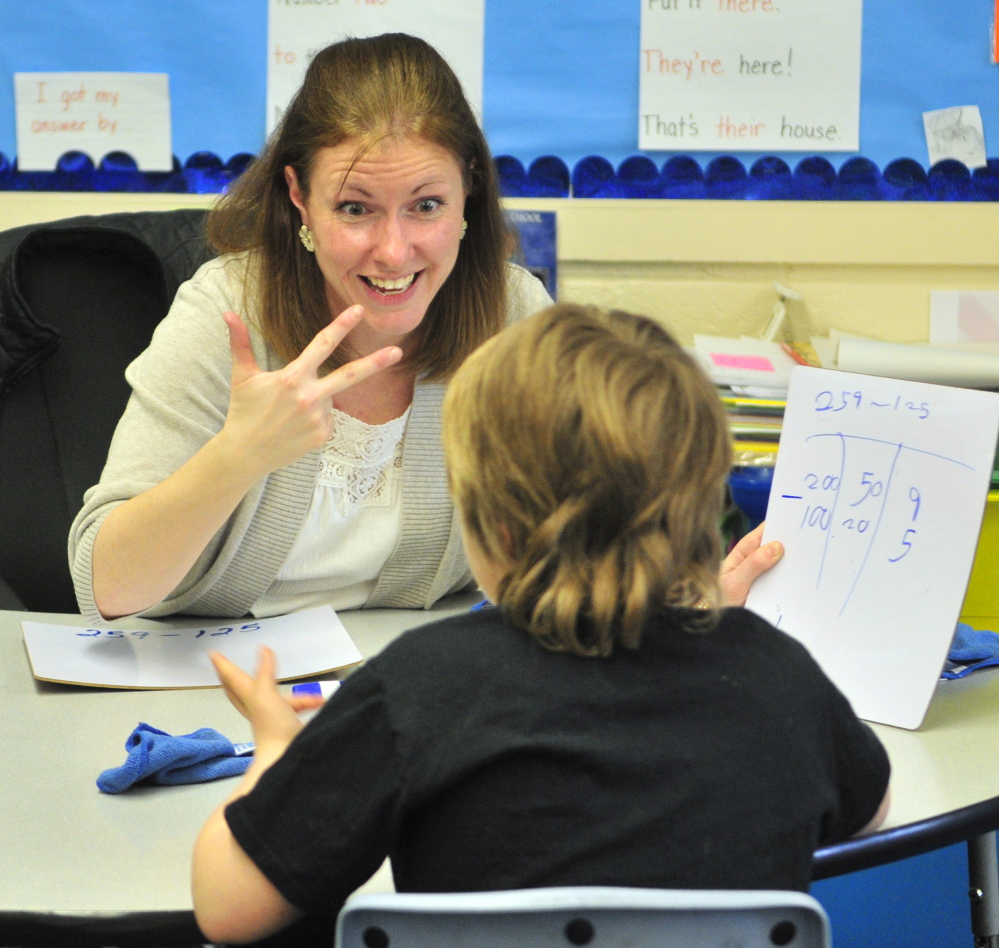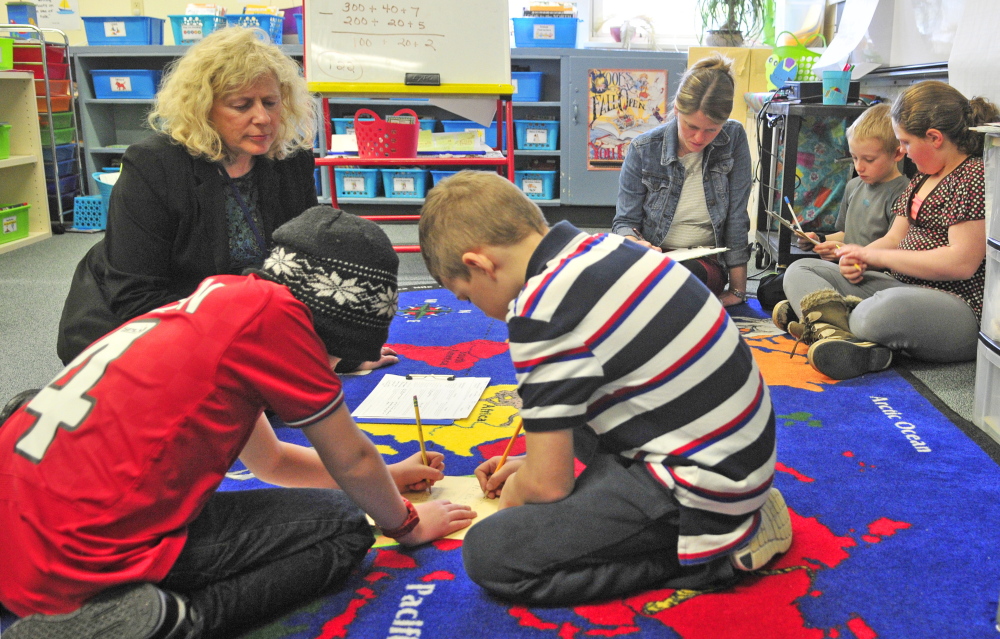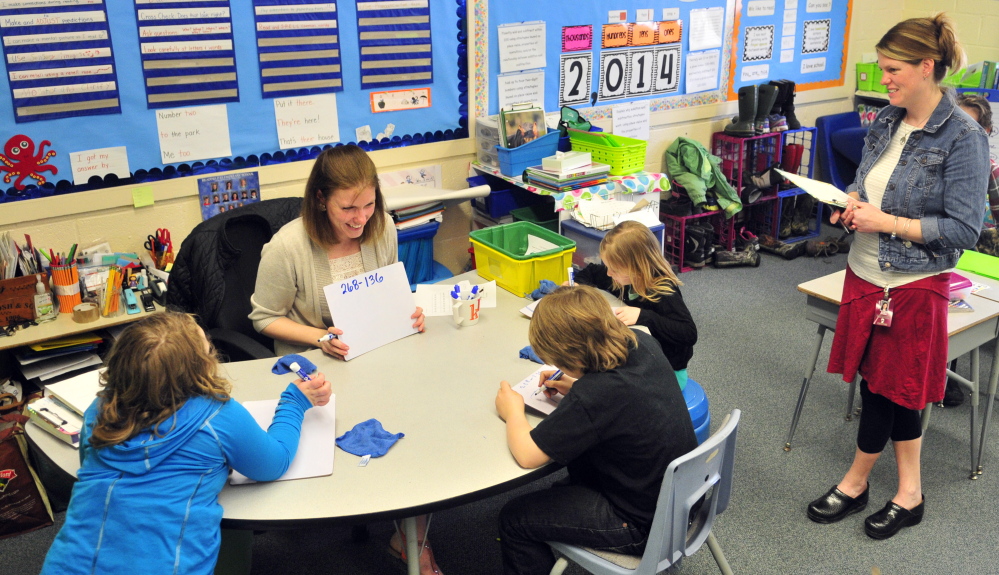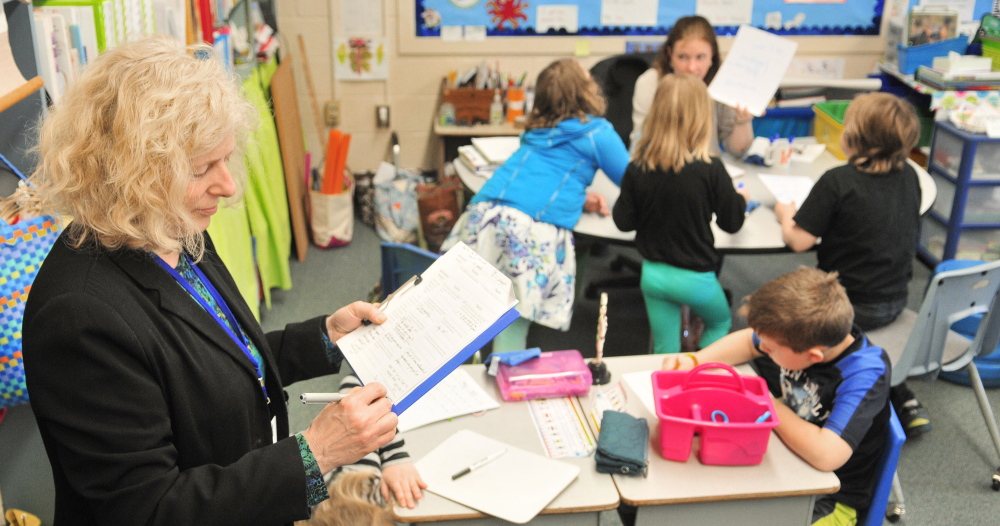Evaluating teachers can be a contentious subject, but teachers and administrators at two central Maine elementary schools are using an evaluation strategy that they say is improving instruction and creating a culture where teachers learn from each other.
Twice a month at Readfield and Wayne elementary schools, teachers and administrators visit math classes for 10 minutes at a time to look for evidence students are using certain Common Core learning methods and that teachers are encouraging the methods.
After visiting the classes and interacting with the students, the teachers and administrators spend 15 minutes discussing what they saw and whether they agree with each others’ examples of evidence that the standards were met.
Jeff Boston, principal of Readfield and Wayne elementary schools, said the program began with the schools trying to find evidence to show they’re meeting their math goals in the Common Core standards, academic standards adopted by 43 states to prepare students for entering college and the workforce.
Boston first brought the idea to teachers at Wayne Elementary School and third- through fifth-grade teachers at Readfield Elementary School last year and asked if they would be willing to try it. They all agreed, and the method has spread to all of the teachers at the two schools, Boston said. Both schools are kindergarten through fifth grade.
Now, the teachers and administrators who have led the effort will be presenting what they’ve learned at the National Council of Supervisors of Mathematics annual conference in Boston, Mass., next week.
Abby Shink, a third-grade teacher at Readfield Elementary School, said being chosen to present at the conference is an affirmation that what they’re doing has value. She said even though other teachers aren’t visiting her classroom every day, the practice of preparing for the visits improves her instruction and makes it easier to incorporate the learning standards every day.
“I think it’s good to have that additional layer, feeling like you’re being held accountable for what you’re teaching,” Shink said.
Jennifer Tweedie, second-grade teacher at Readfield Elementary School, said the walk-throughs have led her to be more intentional with her planning because she has received feedback on what type of lesson plans work. Seeing other teachers in action also makes her reflect on her own teaching, she said.
“You start asking yourself questions,” Tweedie said. “‘How did she get all of those kids to all do that, sit down and talk? What other types of questions is she asking that I’m not?”
The schools surveyed the teachers and found that 90 percent of them said the classroom walk-throughs improved instruction, said Sarah Caban, mathematics coach for Readfield-based Regional School Unit 38, which covers Manchester, Mount Vernon, Readfield, and Wayne.
Caban, who typically leads the debriefing discussions after the walk-throughs, said it’s been difficult at times to implement the program, and teachers don’t always like the complications it adds to their days.
“The brunt of the hard stuff falls down on the teachers,” Caban said. “Just to open your door and say ‘Yeah, come in and watch.’ I mean, that’s hard. They do it in medicine, but we haven’t always done it in education.”
But she said teachers have been embracing the process and helping each other learn, taking the lead in their own professional development.
The district began implementing Common Core standards three years ago, Caban said. Although Common Core has standards for content — for example, that second graders should be able to add and subtract numbers less than 20 by the time they move to the next grade — the teachers on the walk-throughs are reviewing whether teachers are incorporating the mathematical practice standards.
The practice standards describe more of the methods of learning the students should develop. The first practice is that students should “make sense of problems and persevere to solve them.” The content standards progress as the students move up grades, but the practice standards for mathematics remain the same through all the grades.
The walk-throughs focus on looking for just two practice standards, but the teachers keep the other Common Core standards in mind. After a walk-through Friday, they asked each other if what they saw covered some of the other standards.
Nancy Harriman, curriculum coordinator for the district, said a strength of the program has been that all teachers at both schools are participating, and that the teachers have been willing to put in the extra time and effort to improve.
“And the expectations are really high,” she said. “We expect a lot of teachers these days. We’ve always expected a lot of teachers, but it’s much more articulated now.”
Caban credited Boston, principal of the two schools, with getting the teachers to buy-in and coordinating the complicated schedule maneuvering to make it possible. The schools haven’t had to spend additional money to implement the program because other teachers or staff members have volunteered in teachers’ classrooms when they’re doing the walk-throughs, he said.
Boston said the strategy is based on work by Robert Marzano, an education researcher who has written about using learning rounds to support teacher growth.
Samantha Warren, the spokeswoman for the Maine Department of Education, said the state rule governing teacher evaluation systems requires peer observation. Work on peer observation systems will be happening across all schools in the state starting next year, although the department knows it’s already happening at many schools, Warren said in an email. The systems will be fully implemented in the 2016-2017 school year, she said.
Warren said “peer observation helps foster a culture in a school building that truly embraces lifelong learning, which is exactly what teachers should be modeling for their own students.”
Other schools in RSU 38 are interested in incorporating the method themselves, Caban said, but it could be difficult to implement logistically, particularly in the middle and high schools, where students rotate to different classrooms throughout the day. Teachers at some of the other schools already visit each others’ classrooms, but it’s not as regular or structured as this program, Caban said.
She said the process may expand to the Manchester and Mount Vernon elementary schools, and teachers from Mount Vernon Elementary School will be participating in walk-throughs in May.
However, the program will only work if the teachers want to do it, Caban said.
“The minute you say, ‘You are all doing learning rounds. You have to let us in your classrooms,’ it really makes it challenging to grow and learn,” she said.
Paul Koenig — 621-5663
Twitter: @paul_koenig
Send questions/comments to the editors.






Success. Please wait for the page to reload. If the page does not reload within 5 seconds, please refresh the page.
Enter your email and password to access comments.
Hi, to comment on stories you must . This profile is in addition to your subscription and website login.
Already have a commenting profile? .
Invalid username/password.
Please check your email to confirm and complete your registration.
Only subscribers are eligible to post comments. Please subscribe or login first for digital access. Here’s why.
Use the form below to reset your password. When you've submitted your account email, we will send an email with a reset code.